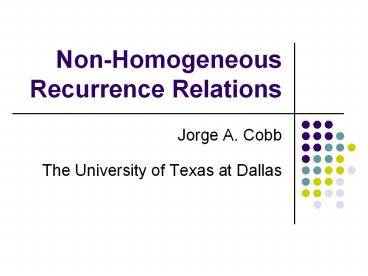Non-Homogeneous Recurrence Relations PowerPoint PPT Presentation
1 / 17
Title: Non-Homogeneous Recurrence Relations
1
Non-Homogeneous Recurrence Relations
- Jorge A. Cobb
- The University of Texas at Dallas
2
Linear nonhomogeneous recurrence relations
- Still constant coefficients
- Non-homogeneous
- We now have one or more additional terms which
depend on n but not on previous values of an - Examples
- an an-1 n, an an-2 n2 1
- General form
- an c1an-1 c2an-2 ... ckan-k F(n)
3
Associated homogeneous recurrence relation
- If we ignore F(n) in the previous form, we obtain
the homogeneous recurrence relation associated
with the non-homogeneous one we are trying to
solve - Theorem 5 If an(p) is a particular solution
for a nonhomogeneous recurrence relation, then
all solutions are of the form an(p)an(h),
where an(h) is a solution of the associated
homogeneous recurrence relation
4
Proving Theorem 5
- Suppose an(p) is such a particular solution
(for non-homogeneous) and bn is another
solution (also for n.h.) - an(p) c1an-1(p) c2an-2(p) ... ckan-k(p)
F(n) - bn c1bn-1 c2bn-2 ... ckbn-k F(n)
- By subtracting the first equation from the
second, - bn an(p) c1(bn-1 an-1(p)) ... ck(bn-k
an-k(p)) - bn an(p) is a solution of the associated
homogeneous recurrence relation. - Hence, bn an(p) (bn - an(p)), which
is what we want
5
Finding solutions
- Finding a particular solution is the tricky part
- There are general solutions for certain classes
of functions F(n) but not for every possible F(n) - Sometimes, we have to guess on possible forms
based on F(n)
6
Example
- an 2an-1 2n, a1 6
- Any homogeneous solution is
- an(h) b2n for some constant b
- For a particular solution, guess
- Why guess? If it works, it might lead us to a
general theorem
an(p) cn d
7
Continued
- an(p) cn d (from guess) 2an-1(p) 2n
(from recurrence relation) 2(c(n-1) d) 2n
(from guess of an-1) (2c 2)n 2c 2d - cn d (2c 2)n 2c 2d (all of the above
together) - 0 (c 2)n (d 2c) (can we make it 0 for
all n????) - c 2 0 ? c -2
- d 2c 0 ? d 4 0 ? d -4
8
Example continued
- We determined that any solution of the recurrence
relation is of the form an 2n 4 b2n - What is b? (for our desired solution)
- With a1 6, we have
- a1 6 21 4 b21 6 2b
- b 6
- an 2n 4 62n is our desired solution.
9
Polynomial and exponential F(n)
- Theorem 6 If the function F(n) is of the form
F(n) (btnt bt-1nt-1 ... b0)sn, then - If s is not a root of the characteristic equation
of the associated homogeneous recurrence
relation, there is a solution of the
form (ptnt pt-1nt-1 ... p0)sn - If s is such a root with multiplicity m, then
there is a solution of the form nm(ptnt
pt-1nt-1 ... p0)sn
10
Examples
- an 6an-1 9an-2 F(n)
- Characteristic eq r2 6r 9 (r - 3)2
- Root r 3, multiplicity m 2
- We consider cases where F(n) Q(n)sn, for some
polynomial Q
11
Examples (continued)
- Assume F(n) 3n
- F(n) Q(n)sn 1?3n
- degree t 0, s 3 is a root of mult 2
- Particular solution is of the form
- nm(ptnt pt-1nt-1 ... p0)sn
- n2(p0)3n
- Assume F(n) n3n
- degree t 1, s 3 is a root of mult 2
- Particular solution is of the form
- nm(ptnt pt-1nt-1 ... p0)sn
- n2(p1n1 p0)3n
12
Examples (continued)
- Assume F(n) n22n
- F(n) Q(n)sn n22n
- degree t 2, s 2 is not a root
- Particular solution is of the form
- (ptnt pt-1nt-1 ... p0)sn
- (p2n2 p1n p0)2n
- Assume F(n) n23n
- F(n) Q(n)sn n23n
- degree t 2, s 3 is a root of multiplicity 2
- Particular solution is of the form
- nm(ptnt pt-1nt-1 ... p0)sn
- n2(p2n2 p1n p0)3n
13
Sum of integers
- an 1 2 ... (n1)
- Recurrence relation
- Associated homogeneous RR
- The homogeneous RRs characteristic equation is
- The homogenous solution is thus of the form
- a0 1, so ..
an an-1 (n1)
an an-1
r - 1 0
an b1n b
nope, you cant find b yet ?
14
Sum of integers
- an an-1 (n 1), F(n) (n 1)
- F(n) (btnt bt-1nt-1 ... b0)sn
- F(n) (n 1) (n 1)1n
- thus t 1, b1 1, b0 1, s 1
- Recall that the homogeneous RR characteristic
equation has root 1 with multiplicity 1 - s is thus a characteristic root with multiplicity
1
15
Sum of integers continued
- A particular solution is of the form
- nm(ptnt pt-1nt-1 ... p0)sn (recall
F(n) n1) - an n1(p1n p0)1n p1n2 p0n
- an an-1 n 1
- p1n2 p0n an-1 n 1 p1(n-1)2
p0(n-1) n 1 p1(n2 2n 1) p0(n-1) n
1 p1n2 (-2p1 p0 1)n (p1-p0) 1 - (-2p1 1)n (p1-p0) 1 0
16
Sum of integers continued
- (-2p1 1)n (p1 - p0) 1 0
- For this to be true, -2p1 1 0 ? p1 1/2
- (p1 - p0) 1 0
- and p0 p1 1 3/2
17
Sum of integers continued
- Therefore the particular solution is
- and all solutions are of the form
- From the initial condition a01, we obtain
- a0 1 0(0 3)/2 b, so b1

